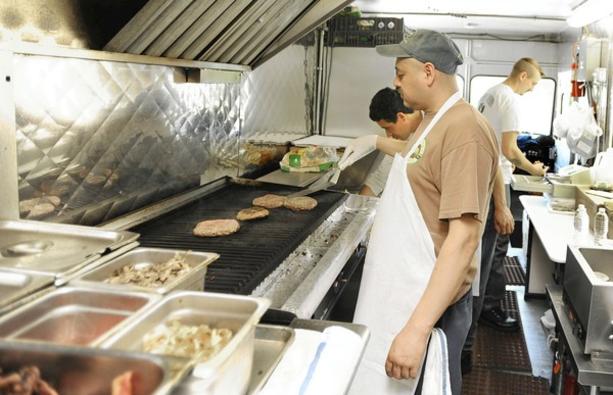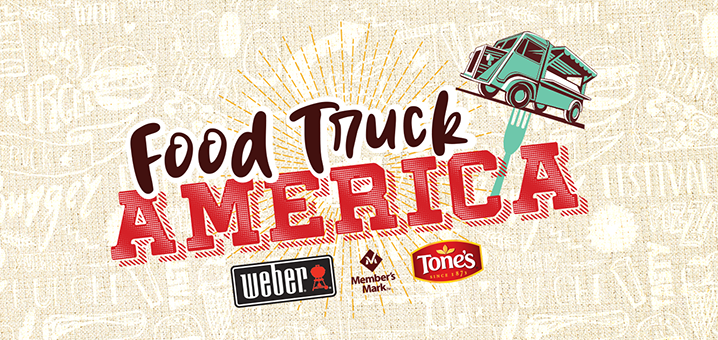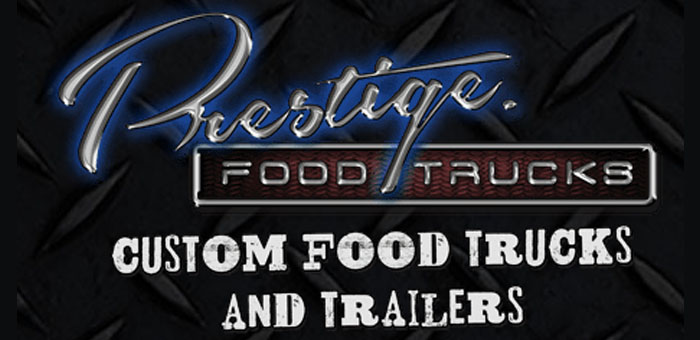For the mobile bistros, location is everything, but finding prime spots has gotten harder
BALTIMORE, MD – After getting chased off the Johns Hopkins Hospital campus for the second time in two weeks, then shooed away from Harbor East, where she only paused to strategize, Irene Smith pulled her orange truck, sloshing with soup, to a spot near Fallsway and Gay Street, trying to salvage the day.
Her motor had barely turned off before a hotel manager told her she had to move. When she pulled forward to satisfy the hotel manager, a meter maid warned her away from the two-hour parking area. After pulling up still farther, a property owner began yelling that Smith’s truck — with its gourmet, organic bisques and chowders — would attract the wrong element.
“That’s the life of a food truck,” says Smith, with no small amount of exasperation. “It’s not about the food, it’s about finding a parking spot and getting yelled at.”
Baltimore’s fledgling food truck community is learning that despite being a doted-on darling of the foodie lunch crowd, the city streets can be unforgiving. With conflicts popping up as fast as the mobile lunch vendors themselves, a summit among truck owners and traditional downtown businesses is already under discussion.
“This is a phenomenon,” says Mike Evitts, spokesman for the Downtown Partnership, where officials have already heard a smattering of complaints from owners of brick-and-mortar restaurants who feel threatened by the trendy trucks. “The question is how do we handle food trucks? How do we handle one type of vendor versus another? We’ve just begun to have conversations about this.”
The granddaddy of Baltimore’s food truck movement, Kooper’s Chowhound Burger Wagon, celebrated its first birthday last fall. The other five that frequent the city, selling items that include burritos and crepes, are stalked by aficionados eager for a taste of the concept that’s so wildly popular in cities like Los Angeles, New York and Portland, Ore., the Food Network devoted a reality show to it.
Yet not everyone in town is so welcoming.
Smith, who launched her Souper Freak soup truck in March, selling exotic stews and homey favorites, runs into parking trouble almost daily. Besides being asked to leave several times from Hopkins Hospital, where an official told her she was competition for the campus cafeteria, the rolling Souper Freak has been chased away from Morgan State University, a spot near the Waverly Farmers’ Market and from Herring Run Park.
Just last week, no-parking signs popped up in the spot Smith likes near the University of Maryland Medical Center, forcing her to take a last-second detour on Monday to Paca and Fayette streets, where, she says with a sigh, “I can’t even see the medical center.”
“You would think a place would be excited about this as a possibility in their city,” she says. “But people don’t yet know what to do with us. … I don’t think Hopkins, a multimillion-dollar player in the state, should be concerned about a lady selling gazpacho on Tuesdays.”
When asked about the food truck situation, a Hopkins official diverted questions to the Baltimore Police Department. A police spokesman said the truck had been parked in a 15-minute zone.
“We have the vehicle on tape being there from 9 a.m. to 1 p.m.,” said police spokesman Anthony Guglielmi. “When she was confronted, the only thing the vendor produced was a health certification, not any other permits or vendors’ licenses.”
Guglielmi said the truck owner was not cited, only asked to move.
Owners of the Gypsy Queen truck, which opened for business on New Year’s Eve, ran into issues almost immediately. Partners Annemarie Langton and Tom Looney staked out what they thought would be a sweet spot near Power Plant Live. They couldn’t have been there more than an hour or two before a restaurateur — Langton isn’t sure who — came out and told them they’d have to move.
“He was very rude and very upset,” Langton says, remembering how she told him, “I’m sorry but my permit says I’m fine as long as I’m 300 feet from any restaurant serving the same product.” The man insisted he served the same product. “I’m pretty sure they didn’t have crab-cake tacos, black truffle sliders and a mac-and-cheese cone with bacon relish on their menu. But we went ahead and moved.”
All Baltimore food truck owners will tell you they follow posted parking rules — feeding meters if needed. They’re also to stay 300 feet from schools. (The laws have long been on the city books, originally intended to regulate hot dog carts and the ice-cream man.)
Unlike Souper Freak, Gypsy Queen has had great luck parking near Hopkins Hospital. In fact, Langton boasts about her choice of spots — mainly because her nook at Ashland and Wolfe streets is essentially a commercial dead zone. They made it work by creating buzz on Facebook and Twitter, luring customers off the beaten track.
“We hustled,” says Langton, who now serves about 200 lunches there most Thursdays. “It took months.”
Bill Irwin, who owns Kooper’s burger wagon, has had big success — and big failure — trying to park at Commerce and Pratt streets near the Inner Harbor. When he can get the truck there, business is great. Other times, he’s ticketed for a variety of reasons and forced to find another spot.
“I think someone knew someone who knew someone, and they just pushed us away,” says Irwin, who sometimes tries to avoid these parking hassles by setting up in business parks, often in the suburbs.
It’s hard to find business owners in the city who openly wish flat tires on the new food trucks. James Hughes, general manager of Rosina Gourmet downtown, gently concedes that the trucks have cost him business — “a couple of sandwiches'” worth.
Boheme Cafe owner Martha Lucius says she was certainly leery of them at first — before adopting a live-and-let-live philosophy. “I’m sure if they weren’t here, I’d probably get more business,” she says. “But what’s wrong with a little variety? If my customers don’t want to eat my food every day, that’s OK.”
Find the entire article <here>




